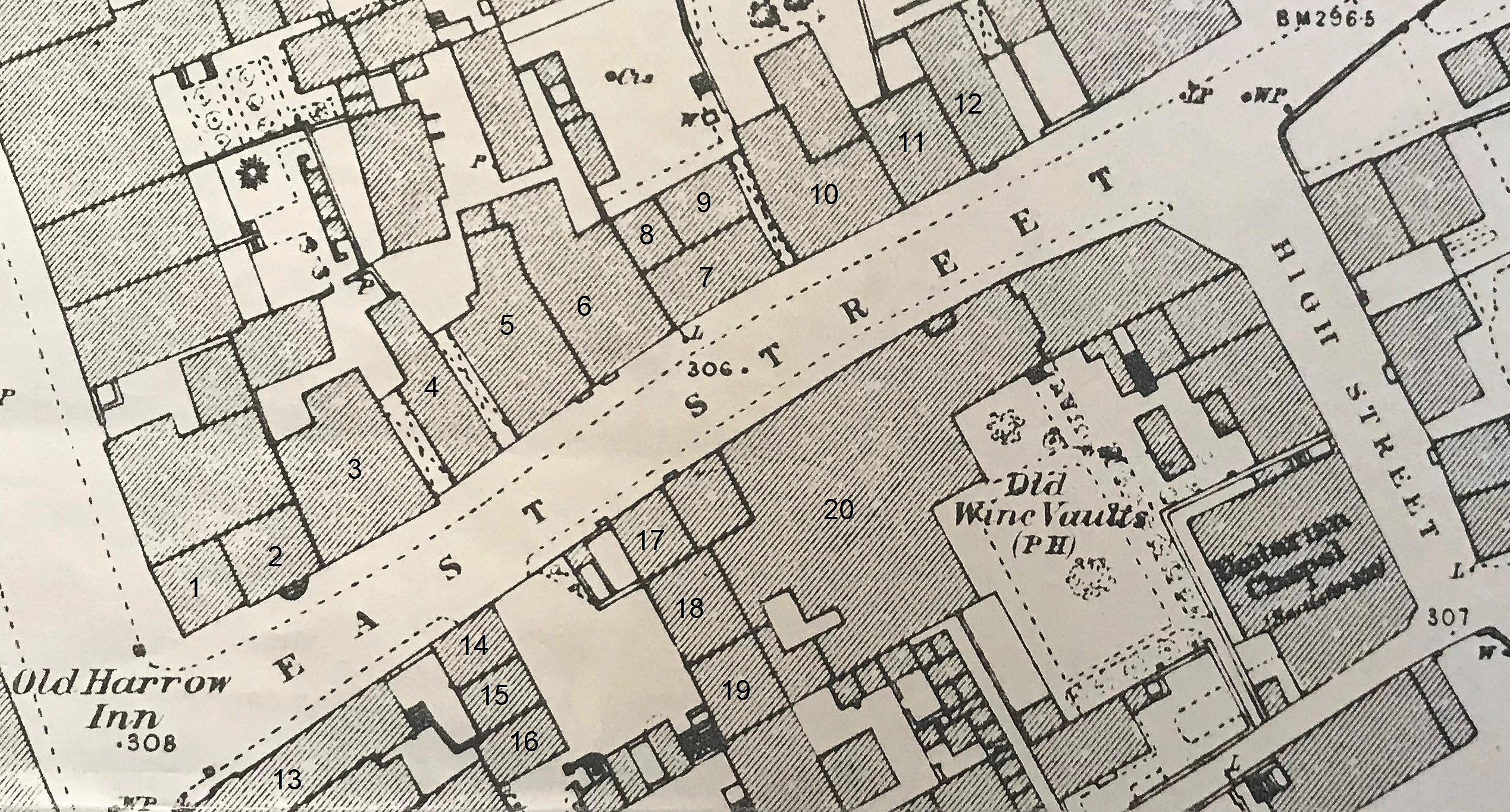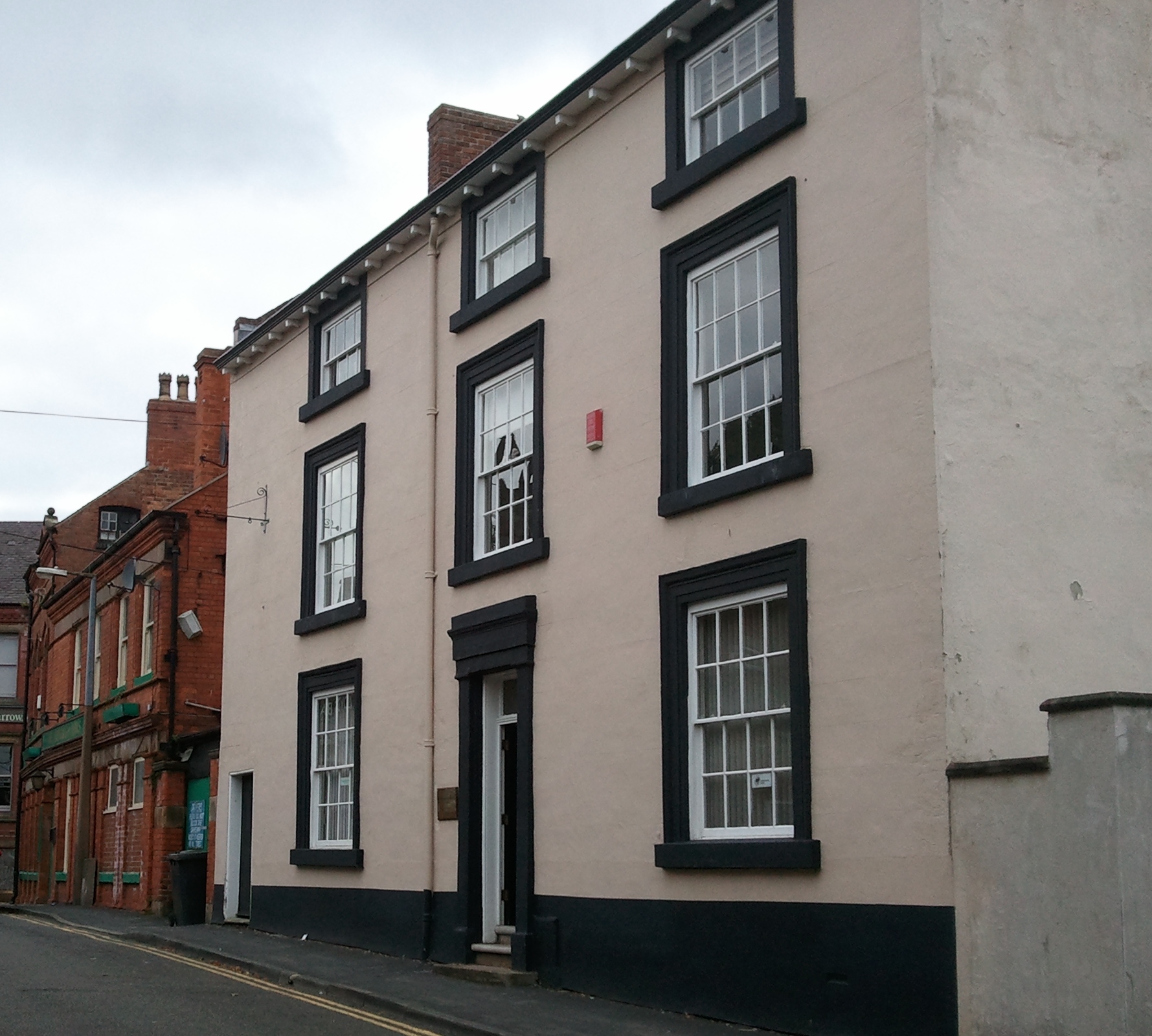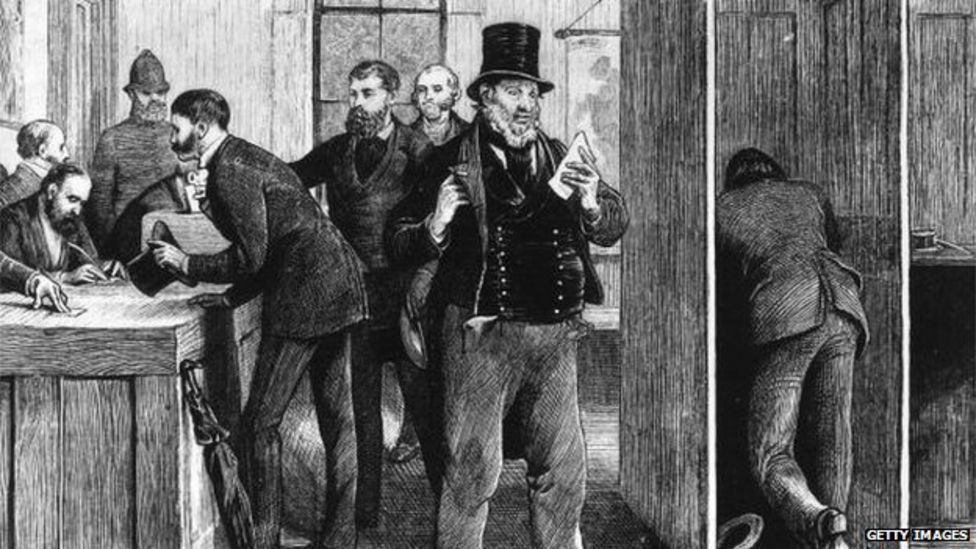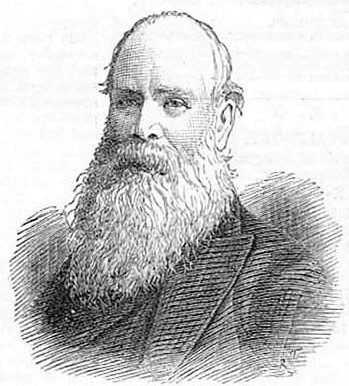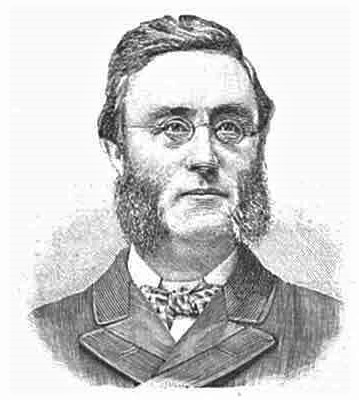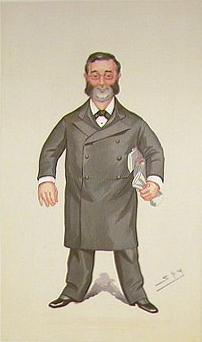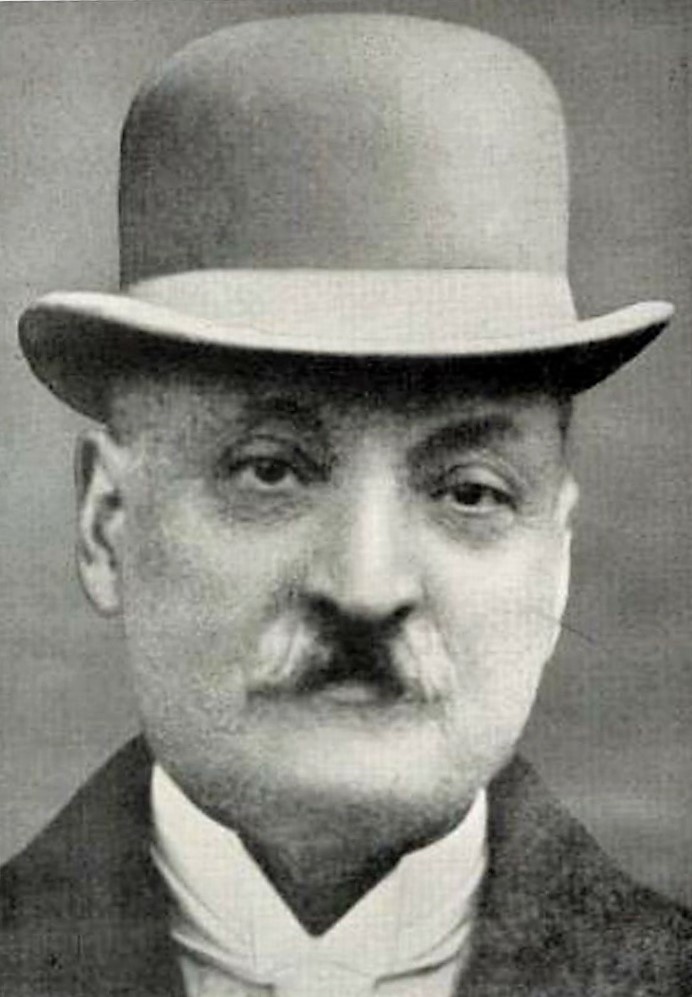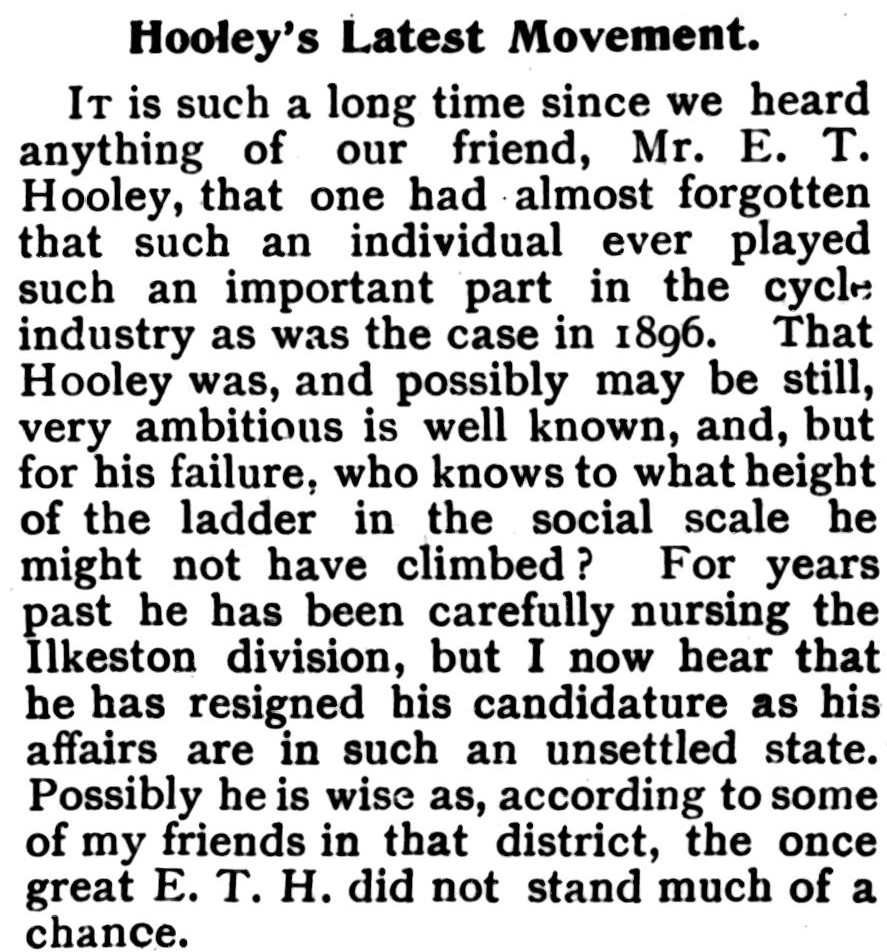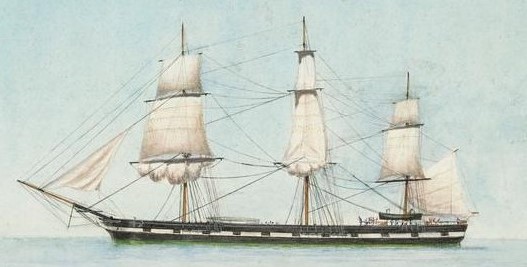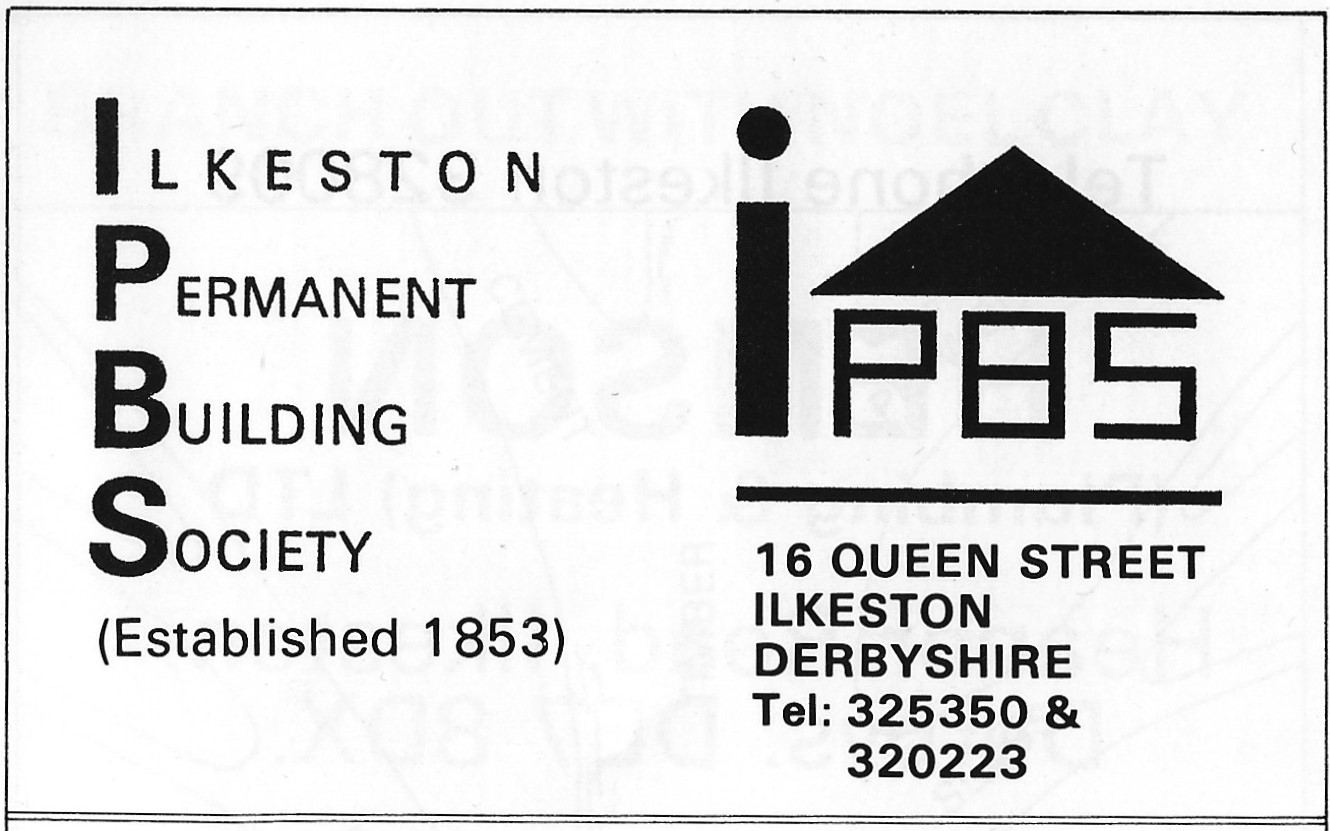Leaving behind the Columbine neighbours, Adeline now writes about a residence she is very familiar with.
“Next were two larger houses. The first was where my sister and myself were born. When we left the East Street House it was divided into two parts”. (house 5 on the map below)
“The back part was occupied by Miss Hannah Mellor, sister to John and William Mellor, butchers, of South Street, and Ilkeston Common.”
The eldest of the ten children (at least) of lacemaker William and Rhoda (nee Palmer), Hannah Mellor was born in 1809 and died in October 1864. Several of her siblings feature elsewhere in the town … for example, younger brothers John and William, both butchers, living at opposite ends of the town.
the Columbine house today
——————————————————————————————————————————————————
A Polling Station.
Adeline should remember this well ….“The front part, except the parlour, was empty for some time. At election times, there were lively scenes between the ‘blues and yellows’. Our parlour was brought into use for the polling station, and I remember seeing old Squire Mundy, who was a rabid Tory, come into the room with his men, and look who they voted for, and woe to the man who dared to vote ‘yellow’, for he would certainly receive his ticket on the following Saturday.
“Peter Stanley, of Cotmanhay, brother to Mrs. Flint Hawley, butcher, of South Street, had the courage to vote against Squire Mundy, and on the Saturday following, received his ticket of dismissal from the Shipley Co.
“But later, nothing daunted, he started a small general shop in his cottage at Cotmanhay. He gradually built up a good business and in his later years was able to retire upon a comfortable competency, which I do not think he would have been able to do had he remained at the pit.”
——————————————————————————————————————————————————
Prior to the national election of 1835, the Conservative candidate, Sir George Harpur Crewe, visited Ilkeston in December 1834. He had just come from Heanor and as he approached the town, accompanied by 30 or 40 voters on horseback, he was greeted by Ilkeston’s Brass Band and a large procession of inhabitants carrying banners. These all proclaimed political slogans like “Church and State“, “Equality of Taxation“, “Purity of Election“, and so on, while the band played “See the conquering Hero comes“. They all stopped at the King’s Head in the Market Place, close to the premises of grocer Thomas Marshall, where it was time for Sir George to give a speech. And this he did — from the window of Thomas’s shop — being loudly and constantly cheered by the assembled crowd. And then he was on his way to Chaddesden.
Post script: Sir George was returned as one of the two successful Conservative candidates in the election of January/February of 1835.
Following the election, in February 1835, the Nottingham Journal referred to “the spacious schoolroom” where a party of 90 and upwards gathered to celebrate the Conservative candidates’ victory. A tea organised by “Ilkeston’s ladies” was followed by a “mystic dance”.
Ilkeston had been a polling place for the Southern division of the county since 1837. In March of that year it was proposed that a petition to increase the number of polling stations in the division be presented, and that Ilkeston be included as such a polling station. It was signed by Thomas Sudbury, John Smith, Thomas Cheetham, Henry Tomlinson, Thomas Potter, George Small, William Hudson, Benjamin Wade, Henry Carrier, Christopher Harrison, James Wilson, Matthew Hobson and Thomas Harrison.
The ‘blues and yellows’ were the supporters and voters of the Conservative and Liberal parties respectively.
At this time there was no secret ballot at elections, as Squire Mundy’s behaviour (above) indicates. Voters could thus be influenced with bribes or threats, or rendered incapable of voting by intoxicating liquor or kidnap.
Edwin Trueman in his ‘History of Ilkeston’ (1880) also describes the scene …
Hundreds of “lambs” were employed by each political party, and were armed with short staffs. “Bottling” the voters was extensively resorted to; even the Sabbath day witnessed these illegal practices being pursued with unflagging energy. On the polling days, a large number of special constables were sworn in, and arranged in two rows, one on each side of the entrance to the old Butter Market — the place where the electors recorded their votes. In the background stood the “lambs” of each party, flourishing their cudgels at each other and making the most disagreeable noises. Brickbats and other missiles were thrown at the cabs, which were occasionally overturned; and voters were subjected to all kinds of mistreatment and inconvenience.
——————————————————————————————————————————————————
1841: the General Election in the South Derbyshire constituency (which included Ilkeston)
John Cartwright was a young lad, aged 7, when he arrived with his family from Eastwood and into Ilkeston on June 15th 1841, just before the 1841 Election. One of his first memories of the town is seeing Edward Miller Mundy (Conservative) and Charles Robert Colville (Peelite Conservative) soliciting the votes of the electors of Ilkeston from the Market Place outside the parish church. He recalls crowds of men, women and children, gay with flying colours of ribbons yellow and ribbons blue, and “the burning of effigies by way of a change“. That was an election which voted in the two men John had seen — both Conservatives (and therefore ‘Blues’), although Colville fought later elections as a Liberal.
In 1847 Edward was re-elected unopposed in the constituency but died two years later, in 1849. A by-election was called at which his relative William Mundy was elected and served as M.P. from 1849 to 1857, and then from 1859 to 1865.
1859: the General Election in the South Derbyshire constituency
The National election of 1859 was recalled by Old Resident who remembered seeing a cab down Chapel Street, pasted with a placard urging, in bold blue letters, ‘Plump* for Mundy!’
(*As this constituency had two MPs, so those eligible to vote could cast two votes. ‘Plumping’ occurred when a voter gave both votes to the same candidate).
Later in the day a large celebrating crowd of Liberal supporters gathered around Pat Pollard’s shop front in the Market Place, clashing together Pat’s pots and pans to announce their victory ‘in the wild paroxysm of delight’.
Votes had been counted in Derby and the Liberals had won both seats in the South Derbyshire constituency.
The Honourable Augustus Henry Vernon and Thomas William Evans were the victorious Liberal candidates and Conservative William Mundy was ‘out in the cold’.
A jubilant Rev. Thomas Stevenson, — alias ‘Hop-o’er-my-thumb’ — minister at the Queen Street Baptist Chapel, appeared at the window of these Liberal Committee rooms opposite the Wine Vaults in East Street to announce to the crowd that “another Tory would never be returned for South Derbyshire”.
The happy throng then moved out of East Street, up the Market Place, to bait John Wombell, editor of the Pioneer and a staunch Conservative, who lived next to the Market Inn.
On this occasion however, John Wombell was to have the last laugh.
The report of a Liberal victory was premature and inaccurate. The Liberals had indeed won one of the two seats for the constituency but the second one was won by William Mundy and not by Lord Vernon.
The official figures were as declared by the High Sheriff ….Evans (Liberal) 3536; Mundy (Conservative) 3185; Vernon (Liberal) 3184.
“Needless to state, the Rev. Thos. Stevenson’s reputation as a prophet naturally suffered materially in consequence of the Liberal ‘victory’ having vanished into thin air”.
Several years later the Ilkeston Advertiser made reference to this election result. “The one vote which gave Mr. Mundy the seat was — his own! He seated himself!” (IA 1883). And in the 1931 General Election, Derby solicitor Abraham John Flint, the National Labour candidate, defeated the incumbent Labour candidate George Harold Oliver, securing a majority of two votes.
There were five recounts and no equivalent of ‘Tommy’ Stevenson to announce premature ‘victory’.
The first general election held under a secret ballot was in 1873, with voters marking their choice with an X in private booths (not a woman in sight)
The first elections for the Ilkeston Division, 1885-1887 — General and By
By 1885 there had been a further two Reform Acts (after the 1832 Reform Act). One was in 1867 and one (in two parts) in 1884 and 1885. The result of these was that the Right to Vote was extended to more and more of the male population. And because this last 1884/5 Reform Act had been passed by Gladstone’s Liberal Party, it was very troubling to the Ilkeston ‘Blues’, especially as a General Election was coming up very shortly.
Some Conservatives were despondent about their party’s chances of winning. ‘An Ilkeston Conservative‘, writing in the Derby Mercury (March 1885) reflected their concerns.
The very fact that the Reform Bill (of 1884/5) is the work of a Liberal Ministry will have a tendency to cause the newly-enfranchised to cast in their lot with the Radicals and so to make the position of the Conservatives more difficult … I have no hesitation in saying that (Ilkeston) will poll at least six Liberals to one Conservative.
By means of the Miners’ Union (the Radicals) have considerably strengthened their hold upon that class while the Conservatives have done little to win their allegiance by counter action. Apathy is unfortunately our worst enemy, and if we are to win at the ensuing election there must not only be hard work on the part of each individual, but there must be a thoroughly clever and eloquent candidate who can … win over that numerous body of electors whose views on politics are never very stable.
‘Radical’ was his unpleasant epithet for extreme and reform-driven Liberals … too much for this conservative Conservative !! His party was doomed at the next election if his local party didn’t pull its collective finger out.
Similarly there were worries within the Liberal ranks. The Derbyshire Advertiser and Journal, a Liberal newspaper, was quite impressed with the candidate chosen for this election by the Ilkeston Conservatives — he was William Drury Nathaniel Drury-Lowe, “a landowner belonging to an old Derbyshire family, the members of which have always possessed the respect and esteem of their neighbours … a gentleman of experience and ability”.
However the same newspaper was not too keen on the candidate representing the Liberal Party ……
…… Thomas Watson, a non-conformist silk manufacturer from Rochdale, of advanced views… in favour of the separation of the Church from the State … there are thousands of moderate Liberals, like ourselves, who would firmly and vigorously oppose carrying into legislative effect any such revolutionary measure …
…… And surely a local candidate could have been found who would have proved a formidable opponent to the opposite side.
He is by no means the best or strongest candidate who could have been obtained.
The newspaper therefore looked sadly towards his defeat.
This was the first year that Ilkeston had appeared as a separate parliamentary district. It was the smallest in Derbyshire, stretching from Sawley in the south to Pentrich in the north, and stretching east and west from Breadsall to Ilkeston. No place was further than eight miles from the town so that the candidates’ headquarters were in Ilkeston. The town itself was divided into five polling sub-districts, each with its own polling station — the Free Church Sunday School in Wesley Street, Cotmanhay; the Holy Trinity Infants School in Awsworth Road; the British School in Bath Street for the Station Road district; the Market Hall for the Market Place; and the Kensington Board School for Nottingham Road (including Kirk Hallam).
Canvassing by both candidates and their supporters started at the end of April, continued throughout the summer, into the autumn and up to the polling date of December 1st (in the Ilkeston District, though it varied in other neighbouring areas). And just to remind electors, the Nottingham Evening Post on polling day, noted that William Drury-Lowe “ bears a name which is honoured in every patriotic household in Derbyshire” while Mr. Watson “came a complete stranger to the division … with a decided leaning to Radicalism”. Despite this, Thomas Watson was the strong favourite to win this ‘Liberal’ seat.
The mills and collieries stopped at noon, Ilkeston streets were bustling and the Market Place full. One hundred and fifty extra police were drafted into town from Leeds and Leicester, quartered at the Sir John Warren, but early disturbances were almost totally absent. The result was known by the following day and the voters had chosen ‘Radicalism‘ over ‘Patriotism‘, by 5780 to 3793. Votes cast were 9573 out of a total electorate of 10.650. The district’s miners had come out strongly in favour of “the Radical“.
The whole election has passed off in the most orderly manner
Post Script … Following the defeat of the ‘new’ Gladstone Government in June 1886 over the First Home Rule Bill (The Government of Ireland Bill) there was another General Election in July of that year. Once more Thomas Watson was returned as MP for Ilkeston, though with a much-reduced majority; he polled 4621 votes to Samuel Leeke’s 3793. This was a result of many ‘Radical abstentions‘ on account of the Home Rule Issue. However Thomas Watson’s tenure as Ilkeston’s first MP was tragically very short. He died on March 7th of 1887.
On the next day the Derby Daily Telegraph reflected that “the Dissenting element is exceedingly powerful in Ilkeston, and Mr. Watson was a Dissenter of the Dissenters”.
Sir Balthazar Walter Forster, (usually referred to as ‘Walter’) president of the National Liberal Federation, was chosen to fight the by-election and ‘was certain to succeed‘.
Samuel Leeke, who had contested the seat at the previous election, was chosen once more to represent the Conservatives.
A few days before the poll, official nomination papers had to be submitted, and candidates had to submit their cheques to the High Sheriff, residing at Ilkeston Town Hall, for their share of the election expenses. Once this was done the official then had to send a telegram to the Post Master confirming the nominations, a notice of which then had to be displayed in the post office window. All this was done !! It should be noted however that the post office was only a couple of doors away from the Town Hall.
At the poll, on March 24th, Sir Walter was returned with an increased majority — 5512 against 4180 — the Radicals who had abstained in the previous election now returning to vote.
——————————————————————————————————————————————————
Liberal Ladies
This was a time of heightened political activity in Ilkeston which coincided with the Incorporation of the town (1887). Shortly after Walter Forster’s election as the town’s (Liberal) M.P. and the elevation of Francis Sudbury to the position of (Liberal) Mayor of Ilkeston, a Ladies’ Liberal League was established, to counter the influence of the now firmly-established (Conservative ) Primrose League which had appeared in Ilkeston in early 1886. President was Elizabeth Sudbury, Francis’s wife, while secretary and treasurer was one of George Haslam’s daughters. One of its first guests to speak at a local meeing was Emily Martha, Lady Foster, wife of Walter.
At that meeting and public tea (3d per head), on May 24th, when over 1000 attended at the South Street Schoolrooms, all the speakers were women and several alluded to the right of women to take an interest in politics though none — it seems — mentioned a woman’s right to vote*. The Derby Daily Telegraph (May 26th) thus questioned their status; “in almost all respects women have been properly admitted to an equal participation with men in public life and action. It is almost incomprehensible that neither political party has made up its mind to give to women … the right to vote …”
*At a meeting of the Primrose League in late September of 1887 in Ilkeston Town Hall, the chair was taken by Dr. Robert Wood who declared, to loud cheers, that he was in favour of “admitting women to the franchise, and he hoped that they would soon break down the portals debarring them from political rights in the same way as they had already done in the medical profession” (The doctor lived long enough to see this partially achieved)
——————————————————————————————————————————————————
The 1892 General Election
For the 1892 July National Election there was no call to nominate a new Liberal candidate — the town’s Liberal members were well-pleased with their incumbant. Consequently, on June 10th, at a meeting of the Division’s Liberal Association at the Liberal Club in the lower Market Place, Sir Walter’s candidacy at the upcoming election was unanimously confirmed.
In his grateful acceptance speech, Walter referred to his stipulation, made when he became the candidate in 1887, that he should be required to do no house-to-house canvassing, as he would be far too busy representing the interests of the constituency in other ways. However he would continue to promulgate advanced Radical notions and work for old and true Liberal principles. He emphasised his sympathy with the toiling classes and his desire to bring to them a better standard of life. He would fight the election on “Gladstone vs Salisbury”. At the end, there was no shortage of volunteers to form an election committee to promote Walter’s re-election.
The Conservative candidate was, once more, Samuel Leeke, though many local commentators thought he was fighting a losing battle — “Sir Walter is so firmly entrenched in the Ilkeston Division that his position is impregnable”. Just before the election, Samuel had the temerity to visit the ‘Radical stronghold‘ of Ilkeston for several meetings, the last of which was held in the Market Place, where ‘five of six hundred persons gave the candidate a very attentive and respectful hearing’.
By 1892 there were 12,153 electors on the register, within 26 parishes, and a population (counted in 1891) of 69,192. Ilkeston was its largest polling district, containing 3345 electors (Long Eaton had 1739) and Pentrich its smallest with 99 voters. Unlike present-day general elections, in the nineteenth century they were held over several days. This one took place over three weeks, from July 4th to the 26th. Thus many results had been declared in many constituences elsewhere before the voters of the Ilkeston Division went to the poll on July 15th (Friday) with the votes counted on the following day. By that time, Walter Foster’s nomination had been supported by the first four Mayors of Ilkeston plus Frederick Beardsley of Cotmanhay Road and Nathan Buxton of Ash Street (as well as many others outside of Ilkeston). The Ilkeston residents to nominate Samuel Leeke were Henry Rastall of Taylor Street, Thomas Straw of North Street, George Hallam of Mundy Street, Henry James Collumbine of Ash Street, William Ashley of Wilmot Street, William Dawson of Canal Side, William Fletcher of Bath Street, John Parkin of Bath Street, and Edwin Hall of the Rutland Hotel.
Thus, on Saturday, July 16th, the results were announced from the balcony of the Town Hall amid pouring rain to a crowd of several hundred, and .. no surprise.
Walter Foster = 6185 votes and Samuel Leeke = 4402 votes; a Liberal majority of 1783.
In March 1893, members of the Conservative Association of the Ilkeston Division held a complimentary banquet at the Town Hall where they thanked Samuel Leeke for representing them — and losing for them — three times at the recent General Elections (1886, 1887 and 1892). He had decided to stand no more !! Samuel received a handsome illuminated address, a Chippendale cabinet and chair, and a travelling bag … plus a diamond bracelet for his wife.
A popular M.P.
Walter was a popular M.P. within the town and it was often the little gestures which endeared him to many Ilson folk. In 1894 he was approached by Catherine Lacey (nee Baker), widow of coalminer John and living in Stratford Street, Cotmanhay. Her son Samuel had enlisted in the army a few years earlier and she contacted Walter to help her secure the discharge of her son — she was now 60 years old and had no-one to depend upon for maintenance. Walter promised to try his best and communicate with the War Office. As a consequence, in early November of that year son Samuel arrived back in Ilkeston from serving in India.
——————————————————————————————————————————————————
The 1895 General Election
In the Ilkeston Division polling took place on July 19th when Sir Walter was faced by a ‘new’ Conservative opponent and a total stranger to the district, Edward Picton Baumgarten. However the incumbent M.P. could now point to his past successes, in his effort to be re-elected.
In 1892 he had been made Parliamentary Secretary to the Local Government Board in Gladstone’s fourth administration, becoming the first doctor to hold a ministerial post in Britain. In that position he had organised the sanitation campaign between 1892 and 1895, which successfully prevented the 1893 Cholera epidemic reaching Britain. He also helped construct and pass the Parish Councils Act (1894) giving all women, despite their marital status, the right to vote and serve on parish rural district and urban district councils. Workhouse conditions for inmates were improved, as were those of children and workers — included in the latter, Sir Walter wanted to point to the settlement of the Great Lock-out in the coal trade, improvements in factory inspection, an increase in the minimum wage and the adoption of the ‘Eight Hours’ for Government employees.
However several measures which the Government had desired and had introduced, had been thwarted by the partisan House of Lords … Sir Walter declared that it was time for Democracy to impose its will and subjugate the Lords, quoting John Bright: “A House of Legislature, hereditary and irresponsible, cannot be a permanent institution in a free country”.
Although Sir Walter was the odds-on favourite in the election, many recognised that Captain Baumgarten was a ‘plucky and enthusiastic’ opponent, and one ready to construct a serious contest. However at the outset the question was not whether the plucky Captain would lose, but by how much. His threat was not treated seriously by some; discussing Walter’s opponent in a prominent Ilkeston inn, the locals described him as “a grandson of General Picton, who fought under Wellington at Waterloo, and was killed at the Battle of Trafalgar in the Crimean War” !!!! But as the election campaign progressed there was less mirth amongst Liberal supporters and increasing worry about the Captain’s growing popularity; thus rumours began to circulate about his ‘German heritage‘ and being a ‘Wiltshire Squire, the veritable Prince of carpet baggers!! Of course, how significant his threat was depended upon what newspaper you happened to be reading for your information.
Just before noon on July 20th the result was announced; Sir Walter Foster (Radical) 6215 votes, Captain Baumgarten (Unionist) 5254 votes. Majority 961 votes. The total electorate was 13,175. After the announcement, the two former candidates made speeches to their supporters at opposite ends of the Market Place — Sir Walter from the Liberal Club, and Captain Baumgarten from a window of the Sir John Warren Inn. (Most pubs in the town were Tory supporters, while the Temperance Movement came out strongly in favour of the Liberals). As the Captain had almost halved Sir Walter’s majority since the last election he vowed to contest the next, when he was sure he would emerge victorious. It seemed that the tide was certainly flowing in favour of the Conservatives.
Edward Picton Baumgarten : He was born at Cheltenham and was adopted when a child by a clergyman of the name which he bears. His father was a respected army officer, having held the rank of Colonel in the Bengal Engineers. A grand-nephew of Sir Thomas Picton, who was killed at the Battle of Waterloo, where he held an important command under the Duke of Wellington. His mother was the first cousin of the late Archbishop of Canterbury (Dr. Tait) (From the Derbyshire Times, July 13th 1895)
While the Tories in Ilkeston might have been despondent, nationally the Conservative and Liberal Unionist party won a thumping overall majority of 152 seats. This party under Lord Salisbury won just over 60% of the seats with nearly 50% of the votes. On the other hand the Liberals won just over 26% of the seats with over 45% of the votes — the worst result, in terms of seats, since the party’s formation. Sir Walter may have lost his Government job but he was keen to emphasise the ‘positives’ to his constituents. The Tories had a ‘surplus’ of 100,000 votes this election, which gave them a majority of 152 — to Sir Walter this was a fictitious majority which they did not deserve. In the previous election of 1892 the Liberals had a ‘surplus’ of 200,000 but only a majority of 40.
The national defeat of the Liberal Government brought the ‘Liberal Ladies’ out in force. Three months after the General Election, Lady Marian Foster visited the South Street schoolrooms in the Lower Market Place to deliver a ‘stiring address‘. Despite ‘disaster after disaster’ which the Liberals had winessed over the whole country at the election, Ilkeston had held firm !! Ilkeston folk had been determined to put her husband at the head of the poll !!! (applause) The Women’s Liberal Association of Ilkeston would work tirelessly to organise and educate, in preparation for the next poll. The watchwords were now “Register, register, register !” and “Organise, organise, organise !” followed by “Educate, educate, educate !” (Hear, hear)
Ernest Terah Hooley
In fact Captain Baumgarten did not contest the next election and for a time, but especially in 1896-7, the constituency was nurtured by Ernest Terah Hooley (left). He developed a number of benevolent projects in the Ilkeston Division, and actively and agressively sought to be the town’s next Conservative candidate.
In January 1897, he proposed to set aside £15,000 a year for the purposes of organising charity “in his own district, which embraces a considerable part of Derbyshire .. for the relief of the aged poor, the infirm, and the widows within that area”…words used by his London supporters but which did not go down well in Ilkeston itself.
He also advocated and supported a scheme to set up a Convalescent home for Ilkeston patients at Skegness, “the healthiest seaside resort in the kingdom”.
Some described him as “energetic, enthusiastic, and generous”
But that was only ‘some‘ !!
And E.T’s solicitous nurturing was not in vain; on March 3rd 1897 a crowded meeting of delegates at the Town Hall unanimously selected him to challenge Walter Foster at the next election.
“Ilkeston is the capital town of Hooley-land, and suffers from chronic Hooleyism, a disease which is the outcome of millionaire Hooley’s desire to get into the House of Commons. Hooley is pursuing the policy of buying up political sympathy in vigorous earnest, and is dispensing alms upon a large scale in and around Ilkeston. He has secured the services of the labour leader of the district as charity-dispenser-in-chief, a man who has hitherto been distinguished for his rabid Radicalism. However, from “charity agent” to political agentis a step not at all beyond the pale of probabilty”. (Justice; August 14th, 1897) … Benjamin Gregory, leader of the Derbyshire Miners, was the ‘rabid Radical’.
Shortly after this — in September of the same year — Ernest Terah drove over from Risley Hall to Ilkeston where he was met by the Ilkeston Volunteer Brass Band and the Borough Brass Band. What a welcome !! But his stay was only fleeting for he was off to ‘Skeggy’, accompanied by the Revs. Edward Muirhead Evans and Binney, Ilkeston’s Mayor Samuel Richards, deputy Mayor Charles Maltby, various Council members, and two heavily laden trains carrying about 1000 Ilkestonians; all were there to witness the opening of the Convalescent Home which ET had established and partly financed in Grosvenor Road. It had been originally four houses, taken on a lease for three years. Those houses had been converted into one block of premises, in an adapted Queen Anne style, using Ancaster stone and Earl of Scarborough bricks. The home was now to house a total of 20 beds, with a large dining room in the basement, several reception rooms and a boarding area for visiting relatives. Two houses were to be occupied by male invalids, one by females, and the last by visiting relatives. Its first caretaker was Reuben Wright who had transferred from being caretaker at Ilkeston’s Liberal Club.
The rain poured down most of that day.
And E.T. did not have the field without opposition. As a short article in Justice declared (October 23rd 1897); “While the brassy-faced millionaire is buying up Liberal agents, trades councillors, charity-mongers and Nonconformists wholesale, it is satisfactory to know that there is a militant body of Socialists in Ilkeston that he cannot buy. The Ilkeston Social Democratic Federation represents living principles, the Hooleyites — plunder and pelf”. And three of these Socialists were standing in the up-coming municipal elections of November 1897. When those elections arrived the three Socialists had been whittled down to one — namely the reliable Harry Silburn, boot maker and retailer of South Street, fighting for a seat in the Central Ward — he was a distant fifth out of six candidates. Obviously Ilkeston was not yet ready for Socialism.
E.T. may have had several shortcomings, but lack of confidence was not among them. By the beginning of 1898 he was sure that not only would he fight the next election but that he would appear in Parliament as Ilkeston’s representative.
He also had time to serve in 1898 as President of the Ilkeston Central Ambulance Association, and was on hand to supervise the Ambulance contest at the Town Hall in late February. He noted that “in a district like Ilkeston, with coal mines, workshops, factories, and so forth, it was very necessary that working men should be acquainted with ambulance work so as to be able to render first aid in case of accident. Sometimes they might save life itself, or at other times they might set a broken limb or something of the kind until the doctor arrived. … it found them something to do in the long winter evenings and during the summer months as well“. E.T. then continued to organise the non-working hours of these hard-working individuals … he liked a man with a hobby, and he advised them to make ambulance work their hobby; they would then be doing good both for themselves and for those around them.
The contest which E.T. supervised included a single-handed contest in bandaging, the supposed injuries being a broken collar bone, a fracture of ribs, a wound in the arm involving a tourniquet of the brachial artery, and a head wound. At the conclusion, gold and silver medals along with certificates were awarded by ‘Mrs. Hooley’ (Annie Maria nee Winlaw).
June 8th 1898 signalled the end of E.T.’s political ambitions for Ilkeston when his affairs were brought into the Bankruptcy Court. A few days before, the bailiffs had entered Risley Hall but now they were ordered by the London Official Receiver to leave the premises. However his pending bankruptcy problems weren’t his only judicial headache as several other legal cases were looming on the horizon. All these contributed to the view, held by the Ilkeston Liberals, that E.T.’s candidature for that division was at an end; this view was reinforced by the terms of the Bankruptcy Acts which confirmed that his candidature was now void. However he soon made it known that he was exceedingly confident of securing a full discharge long before the next general election, thus enabling him to fight for the Ilkeston seat.
That confidence was misplaced. In a letter dated March 26th, 1900, Ernest Terah announced his resignation as Conservative candidate for the Ilkeston Division in any forthcoming election.
Oh How are the Mighty have fallen (From Cycling Magazine, April 21st, 1900)
And by the end of May 1900 the Ilkeston Division Conservative Association was eyeing up a replacement for E.T. — he was Henry FitzHerbert Wright, barrister and cricketer !! In June Henry was adopted as the Conservative candidate.
Within the next couple of months Henry was out and about in a vigorous tour of the constituency, in an effort to raise his profile, and support for the Conservatives. He was determined to overcome the almost-1000 vote majority which the Liberals had enjoyed at the last election in 1895. His weekliy meetings impressed many of his supporters and he was “making such an excellent impression that Sir Walter Foster’s prospects are by no means as bright as his former large majority would suggest“. (Birmingham Daily Post: August 20th 1900). As the General Election approached, in October 1900, Henry received an encouraging letter from Arthur James Balfour, Leader of the Commons, offering his best wishes for success.
Voting for the Ilkeston Division took place on October 5th, resulting in Henry joining the growing ranks of Sir Walter’s beaten opponents. Votes for Walter = 6633, for Henry = 5698: Liberal majority = 935. With some justification, Sir Walter could now declare that Derbyshire was now the premier Liberal County and an extensive ‘Victory Tour’ around the Ilkeston Division was rapidly organised. The Party had just gained three more Derbyshire seats and now held seven of its nine divisions. The national results however showed a much bleaker picture for the Liberals — there was yet another resounding victory for the incumbent Conservative party which now commanded an overall majority of 133 seats.
——————————————————————————————————————————————————-
The Ilkeston Permanent Building Society.
Adeline’s letter to the Advertiser, quoted in the introduction, mentions….
“… the 82nd annual report of the Permanent Building Society…..interested me very much, much as it has recalled to my memory some incidents of its beginning…..
In 1853 Mr. Samuel Carrier, of H. Carrier and Sons, my father, the late John Columbine, and several other kindred spirits, met in our front parlour to discuss ways and means by which to form a building society, and in 1854, The Ilkeston Permanent Building Society was started.
Mr. S Carrier was secretary until his death in 1865. His brother, Mr. Joseph Carrier, grocer and draper, succeeded him, and held the office until his death in 1880. (In fact Joseph died in 1879).
The monthly subscription meetings were held in the old parlour until the Town Hall was built, when a room for the monthly meetings was engaged. My father sat with the secretary to receive subscriptions on Ilkeston Statutes night, then held the last Thursday in October.”
It should be remembered that Adeline was not born when the events that she is describing here took place.
It may be that she learned of them in conversations with her father, other members of her family, friends and acquaintances. This can always lead to errors, as can a defective memory, especially after several decades.
It is therefore useful to contrast her account with details from the Ilkeston Pioneer of the 1850’s.
The latter reported a first meeting of the Building Society held at Mr. Attenborough’s house in the Market Place – the Sir John Warren Inn — on January 6th, 1853. The meeting was addressed by Mr. C. A. Welby, who outlined the benefits of establishing a building society, and upwards of 30 people gave in their names as members.
One of these was John Columbine, a neighbour of Samuel Carrier, both living in East Street.
Adeline may be partially correct in describing meetings held at her house to discuss the embryonic society, although several of her dates are questionable.
The first annual meeting of the society was held on Tuesday, August 9th, 1853, in a room at the Boys’ National School in the town, chaired by George Small West, and it was reported then that the society had made promising progress even after such a short time. The first Society secretary was Samuel Carrier, a prominent member of Ilkeston’s lace industry, who died on January 20th, 1865, aged 46. He was succeeded as secretary by his brother Joseph, owner of the largest grocery and drapery establishment in the town, who died on a Friday afternoon, October 24th, 1879, at the age of 59. Both are buried in Ilkeston General Cemetery on Stanton Road.
———————————————————————————————————–
Centenary Celebrations 1953
Speaking at the centenary celebrations of the Building Society in April, 1953, guest Mr. H. Collinson, secretary of the Derbyshire Building Society, pointed out that 1853 was the year when…..
— the Crimean War broke out.
— Florence Nightingale (a woman with reputed Ilkeston connections) began her great work for nursing.
— Charles Dickens was writing ‘Bleak House’.
— the best seller of the day was probably Charlotte Bronte’s ‘Villette’.
— coal was 16s (80p) a ton at Cotmanhay.
— a Primitive Methodist Chapel was built at Ilkeston for £500.
— the majority of dwelling houses were built to let and not own, and were soundly constructed, dry and warm, neat terraced houses, and built to last for 100 years.
Mr. Collinson did not point out that 1853 was also the year that..…
— in January, Joseph, the illegitimate son of Mount Street glover Hannah Goddard, died. He was five months old and from the age of three weeks had been regularly given laudanum (an alcoholic tincture of opium) by his mother from an unlabelled bottle to relieve him from pain. The jury at the inquest into his death returned a verdict of natural death.
And in that same month a birth….of the Ilkeston Pioneer and Erewash Valley Gazette.
— in February, patrons of the Ilkeston Mechanics’ Library at the British School rooms in Bath Street heard a lecture on ‘the elements of Geology’ delivered by Marcus Huish of Castle Donington, the fifth in a season of talks at the library. President of the Institution John Ball, lace manufacturer of Burr Lane, chaired the occasion and the audience listened with great attention throughout, showing appreciation with regular bouts of applause.
— in March, at Smalley Petty Sessions, Bath Street collier Moses Lebeter pleaded guilty to travelling on the Erewash Valley Railway not having paid his fare. He expressed remorse and hoped that the magistrates would deal leniently with him. He was fined 20s and 25s costs, or six weeks in prison if he failed to pay this time.
— on April 25th Ann Chandler (nee Wright), wife of blacksmith John of Botany Bay, gave birth to Sarah Ann, the couple’s first and only child after almost ten years of marriage. John was so overjoyed that ‘he could not attend his employment for two days after’. Twenty three years later the daughter Sarah Ann married Henry Buxton, colliery carpenter, and joined him to live at Greasley.
— in May, members of the Independent Chesterfield Order of Odd Fellows celebrated their anniversary in Ilkeston. The Ilkeston Brass Band led them to church service after which over 200 of them sat down for a hearty dinner at the Sir John Warren hotel, hosted by landlord Isaac Attenborough. This was followed by visits to Dr. George Blake Norman at Dalby House and to Henry Mantle Hitchcock at Rutland Mill, at both of which venues they were ‘plentifully regaled with ale’.
More drinking was done back at the hotel and ‘harmony and good feeling prevailed throughout the day’. I bet!!
(Less than two years after this, Henry Mantle Hitchcock appeared at Nottingham Bankruptcy Court where he was declared bankrupt. Consequently in March 1855 up for sale or to let was “a valuable Steam Corn Mill, and capital Messuage, or Dwelling House, with extensive granaries, stabling, coach-house, Garden, Out-offices and appurtenances; and also, about four acres of pasture land, thereto adjoining… held under a lease for the term of 21 years, from the 6th day of April, 1850. Situated within twenty yards of the Erewash Canal, and a quarter of a mile from the Ilkeston Station, on the Midland Railway; and by the terms of the Lease, the Lessor is bound to deliver upon the wharf adjoining the premises, gratis, so much coal as shall be required for the purpose of working the Mill, and for the use and consumption in and about the said Messuage or Tenement, and Buildings”.
With a continuing indiscriminate use of capital letters, the Mill was described as containing “an excellent twenty-six Horse power condensing Engine, with two good Boilers, four pairs of four feet four inch French, and one pair four feet eight inch grey stones in first rate condition; Dressing Machine with Patent Feeders, Smut Machine, and every requisite for carrying on an extensive and lucrative trade”)
And also in that month, Luke Wright, grocer of Cotmanhay Road, found an unusual way to attract customers.
A recently slaughtered pig belonging to Luke had two fully developed and distinct feet on each fore-leg. These trotters could be seen proudly displayed in his shop window.
— in June furnace worker Thomas Copestake, aged 40 (45?), of Codnor Park appeared at Derby Summer Assizes and was committed to Derby Jail to await his trial at the next assizes. He was accused of stabbing collier Thomas Gotheridge in May during a fight on Nottingham Road, both men being rivals for the attention of recently widowed Mary Phipps (nee Attewell), a ‘woman of bad character’. The widow had chosen ‘to keep the company’ of the collier and was ‘walking out with him’, a decision which seems to have angered the furnace labourer and led to the near-fatal assault.
Thomas Copestake was found guilty of wounding with intent and was sentenced to 15 years’ transportation. He served part of his sentence on the floating prison hulk ‘Warrior’, anchored off Woolwich, before being transported with 259 other convicts from Portland, Dorset, in April 1855, on board the ‘Adelaide’, to arrive at Fremantle, Western Australia in July of that year. He died at Perth, Western Australia, in 1886.
Meanwhile Mary Phipps married Thomas Gotheridge in August 1857 and continued to live in Ilkeston.
‘ADELAIDE’. Built 1832 at Calcutta. Wood ship of 640 Tons. She carried 260 male convicts to Fremantle, Western Australia and had one death en-route. She departed Portland on the 19th of April 1855 and arrived at Fremantle on the 18th of July 1855. Master: Captain M. Longman. Surgeon: S. Donnelly.
———————————————————————————————————————————————
We can pause at this point and consider what routine awaited Thomas Copestake on board the ‘Adelaide‘ … this is an account by a convict written in 1852.
A transport frigate about 1852
At six o’clock every morning, the prison door was unlocked by one of these overseers, who called out ” Beds up! ” whereupon every man arose from his berth, rolled up his bedding — consisting of a thin mattrass and one blanket, and took them on deck, where they remained all day to be aired. Then the floor of the prison was scraped and swept in turns by the prisoners who did not fulfil any special office — such as schoolmaster, clerk, captain of the mess. The captains received the day’s rations for their respective messes. Those who liked it got something of a wash with salt water, introduced from the forecastle with a leathern pipe. Ablutions performed under such difficulties led to many practical jokes, and not a few battles.
At eight o’clock, a pint of cocoa was served out to each man; which, with his biscuit, made his breakfast. Immediately afterwards school was commenced, books were distributed, and exchanged; the surgeon examined the sick, heard complaints, and awarded punishments. These consisted of confinement below deck, heavy chains, imprisonment in a kind of sentry box on deck, resembling a Chinese cage, in which the inmate can neither sit, lie down, nor stand upright. We had only one case of flogging.
In the afternoon, we usually had prayers read by the chaplain; sometimes with a moral exordium, which was delivered in an impressive and earnest manner. At five o’clock we had a pint of tea. Neither our tea nor our cocoa bore much resemblance to the beverages which I had previously known under those names; but they were warm and comforting. At six o’clock the beds were taken down and arranged; and at half-past six we were mustered, and returned, one by one to our prison, where we were locked in — a sentinel, with loaded musket and fixed bayonet, being placed at the door.
Our night was thus nearly twelve hours long. It being too dark to read, and as it was impossible to sleep much more than half the time, I was compelled, for four or five hours every night, to hear little else than narratives of offences and criminal indulgences, of the most revolting character. Obscene and blasphemous songs were nightly composed and sung; and schemes for future crimes were proposed and discussed, with a coolness which I shudder to call to mind. The only check on them was the sentinel at the door, who now and then thrust his bayonet between the bars, when it was getting very late or the men were unusually uproarious, and called out ” silence.”
Extract from ‘Transported for life‘ in Household Words (July 31st 1852)
———————————————————————————————————————————————-
— in July, after assaulting Lucy Freeman, Charlotte Stirland alias Houghton (nee Ellis), wife of William, framework knitter of Cotmanhay, was tried, convicted and fined £1 13s or six weeks in jail.
The Pioneer felt unable to print a report of Charlotte’s colourful language used in court.
— in August, one Wednesday afternoon, 77 boys and 60 girls of the British School in Bath Street walked ‘in regular order’ to Dale Abbey and Dale hills, accompanied by their teachers and preceded by Ilkeston Brass Band. This was their annual treat. They returned about 9pm, “somewhat fatigued but much pleased with the afternoon’s amusement”.(IP)
— on September 12th, Sarah Trueman (nee Skevington), wife of John, grocer/higgler of Ilkeston Common, smoked her last pipe — though she didn’t know it at the time. She then walked from her front shop into her back room, started talking with a neighbour, suddenly fell down and died.
At her inquest the jury returned a verdict of ‘Natural death‘. Sarah was aged 53.
— on October 16th, Samuel Richards junior, second son of Samuel and Mary (nee Bostock) — the first son, also called Samuel, had died in childhood in 1827 — married Martha Mellor, daughter of framework knitter William and Rhoda (nee Palmer).
The couple remained married for almost 50 years, living in Cotmanhay Road and having ten children.
(One was Arthur Richards Mellor, born two months before the wedding).
Like his father, Samuel started life as a coalminer but after a serious accident, he converted to the grocery trade. He was a prominent member of the community; a trustee of Ebenezer Chapel, superintendent and secretary of its Sunday School, member of the Local Board and then the Town Council, an Alderman and twice elected Mayor of Ilkeston, in 1896 and 1897. During his second term of office, at the Diamond Jubilee of Queen Victoria, he was invited to Buckingham Palace to attend a reception of Mayors.
Samuel died at 395 Cotmanhay Road in June 1901 and was followed by Martha ten years later.
Both were buried in Park Cemetery.
— in November, druggist and grocer Richard Smith Potts of South Street was offering sufferers of toothache, tic-douloureux and other facial pains, guaranteed and permanent relief by use of Stevenson’s Pills, free from any deleterious drug and which even the most delicate person could take with perfect safety.
— on December 1st, Sally Elizabeth Campbell (nee Outram), wife of William Campbell, tailor and turnpike toll collector of South Street, gave birth to twin girls, five minutes apart. The older twin Elizabeth died of scarlatina during the epidemic of 1858. Younger twin Annie went into service for Francis Sudbury and his family (and in 1895 married John Trueman?)
— The year 1853 started and ended badly for Thomas Sills, proprietor of the Three Horse Shoes Inn on Derby Road.
In January he was charged and convicted of keeping the inn open for the sale of beer beyond the permitted hours of his licence. Thomas was fined £1 with costs of 12 shillings.
And in December Thomas was in trouble again, this time for allowing card-playing on his premises. A fine of £2 and 15 shillings costs followed his conviction, despite his declaration that the cards were not his and he was not aware that the game was taking place.
Perhaps it was this ill fortune which prompted Thomas to transfer his tenancy to William Severn, wheelwright of Moors Bridge Lane, just four months later.
———————————————————————————————————-
About March 1854 the office of the Society was moved from the National School Room in the Market Place to the office of Charles A. Welby in East Street, because of the growth in the Society’s business.
In July 1875 the retiring directors of the Building Society were South Street cordwainer Frederick Mitchell, Thomas Ball of Dodson House and John Columbine. The latter two were re-elected.
John continued his directorship until 1879 when again he was re-elected. He shortly thereafter left Ilkeston for Nottingham.
Advert from Borough of Erewash pamphlet, about 1981
In 2001 the Ilkeston Permanent Building Society merged with the Derbyshire Building Society.
——————————————————————————————————————————————-
Let’s continue along East Street and find out more about the Carrier family

